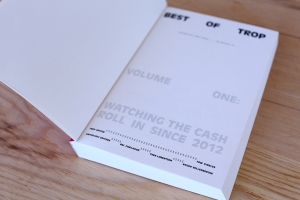Editorial
TAYO
TAYO cultivates emerging poetry and prose, publishing writing that knifes, lifts, and strikes at the emotive truth of all things lost and adrift. TAYO is an annual print, quarterly online, and multimedia platform for storytelling. In Tagalog, tayo means “us” or “to stand up.”
Managing Editor
March 2014 – Present
Below are photos of TAYO Literary Magazine Issue 5. This most recent issue, published in May of 2015, is available to purchase online and in approximately 200 Barnes and Noble bookstores across the country as a result of the help and guidance from Fjords Review.
TROP
TROP is an online literary magazine based in Los Angeles. It features serialized creative writing, literary and pop culture criticism, interviews, personal essays, visual art, reviews of fake movies, and humor writing. Trop is a project of the Pasadena Arts Council’s EMERGE Fiscal Sponsorship Program.
Editor and Project Lead of Best of Trop, Volume One
2013 – 2014
Below are photos of the Trop anthology, titled Best of Trop, Volume One. The anthology collected some of the best pieces from Trop‘s first year. Best of Trop is available to purchase online and at the following independent bookstores: Skylight Books and Book Soup in Los Angeles, The Strand in New York City, and Longfellow Books in Portland, Maine.
Photos of TAYO Issue 5 and Best of Trop, Volume One by: Simone Scarpino
Interviews
Joshua Mohr on his third novel, Fight Song | Trop – Interviews
February 12, 2013
When I start to build a character, I always start to build from what they’re ashamed of. I start to build via their points of humiliation—the system of embarrassments that have followed them throughout their adult lives. Once I have a sense of what they’re ashamed of, it’s very easy for me to build the happy times. But I really need to understand their private world, the memories that they don’t share with everybody else. Once I have a firm handle on that, I can really bring them to life in a way that I feel it doesn’t even matter if you’ve been through a similar situation, you’ll at least be able to understand why that person’s doing what they’re doing, even if what they’re doing is stupid. Read more…
Nishta Mehra on her debut collection of essays, The Pomegranate King | Trop – Interviews
September 10, 2013
This idea that ‘it gets better with time’ is kind of bullshit. I’m not denying that grief changes, but I don’t think we can use the language of superlatives like ‘better’ or ‘worse.’ I think that’s a false dichotomy. That assumes that there’s a fix for grief, and I find that so problematic. Time can actually add to the grief—there’s all this stuff that he’s missed. When he was first gone it was super raw and physical, and I was in shock. But I was projecting ahead to how my life was going to be different. Now I have seven years that he’s already missed, and then, shit. Everything else that comes later, he’s going to miss that, too. There’s just the daily life of existing without him. The other day I caught myself: I thought, ‘Oh my god, Dad would love this!’ It’s been seven years, and it’s still right there.
You will be able to function in your life in a way that you can’t when it first happens, but the idea that grief is a project that at some point you’ll be done with—that sets people up for failure. I’d much rather have people undertake the project of figuring out where to put grief in their lives. You’ve got to figure out how to carry it in a way that works for you. Read more…
Marianne Villanueva | TAYO – Special Issue: Interviews
August 2, 2014
You know I never thought of my characters as victims. Never. I think they are powerful people. Because the neglect, they can turn it to their advantage. And the fact that they can lead that double life, and they have that inner life which no one knows about—that’s completely theirs, they own it. The marginalization, living in the margins, is actually powerful. I like it on the margins, but it also makes me very interior. Because I want to protect that part of me, and I don’t want it exposed very much. I try and keep it hidden, because that is the way I view the world, and I’ve always done it since I was a child. I tend to keep it inside—that’s actually another reason why the women appear stoic is because I appear stoic. Read more…
Liz Mayorga | TAYO blog
December 31, 2014
Like everything else, SFZF will always evolve. A newer generation will take it over. The group dynamic is always changing. People bring new ideas, and we push ways to make things even better. But there are some things we will fight to keep the same, like affordable tables, free admission, and our commitment to DIY art.
Lately, it’s been a challenge to keep things going. Everyone’s aware of how rent has sky-rocketed. Well, the County Fair Building, which is where we’ve had SFZF for the past 10 years, keeps increasing its rent. We’re considering other venues, but it’s hard to find an affordable space in San Francisco that could host more than 100 exhibitors. If we do find a more affordable and accessible location, we may have to decrease in size. While that may help make things more manageable for us as organizers, it would also mean less people will get to participate. San Francisco is already experiencing an exodus of artists; we would like to keep fighting for a space where artists of all socioeconomic backgrounds can exhibit their work. Read more…
Articles
“Literary Death Match: Bringing Bookish Cool to a City Near You” | Black Clock blog
June 23, 2012
“Green Apple Books: Independent Bookstores Just Won’t Quit” | Black Clock blog
October 24, 2012
“#DearMayorEdLee Blog Series: Hunger for San Francisco” | TAYO blog
May 26, 2016
“#DearMayorEdLee Blog Series: Never Too Late” | TAYO blog
June 4, 2016









